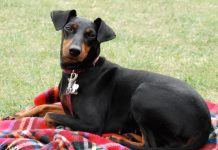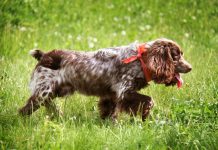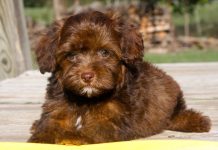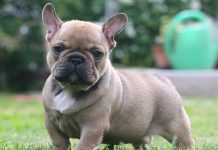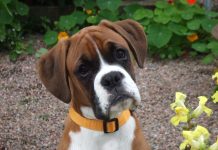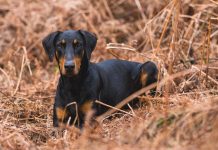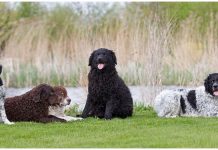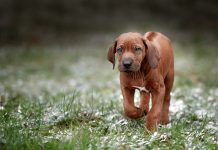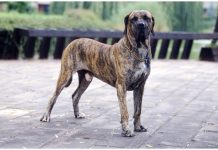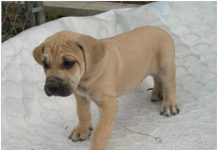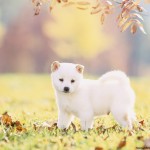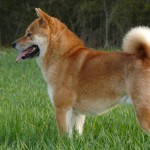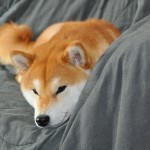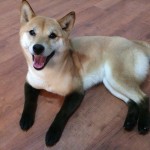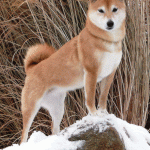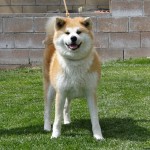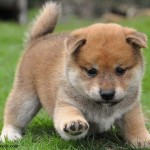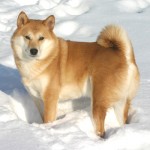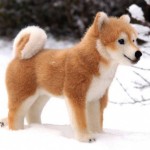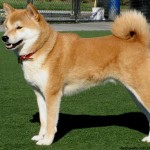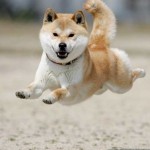The Shiba Inu have been around for over two millennia, were bred to hunt and flush out birds and rabbits and other small game, became almost extinct 70 years ago, but are now quite popular as house pets.
History and Health
- History
The Shiba Inu have been around for almost 2,300 years, according to recent DNA analysis. For virtually all of that time, they were found only in Japan. This led them to become almost extinct during and after World War II.
They were then re-bred from the three remaining bloodlines; the Shinshu Shiba from the Nagano Prefecture (and who were red, small and having a solid undercoat); the Mino Shiba from the Gufu Prefecture (and who had thick, prick ears and a sickle tail, as opposed to the more common curled tail); and the San’in Shiba from the Tottori and Shimane Prefectures (and who were often black and larger).
In 1954, the first Shiba came to the United States, and the first purebred litter was born there in 1979. It was recognized as a formal breed by the American Kennel Club in 1992 and has since become somewhat popular, even appearing on the Doge Internet meme in mid-2013.
- Health
They are considered to be a healthy breed of dogs. However, they are subject to progressive retinal atrophy (PRA), glaucoma, cataracts, hip dysplasia, floating kneecap (or “trick knee”) and allergies. If they do not exhibit any weakness in their joints by the time that they are two years old then it is unlikely that they will develop joint problems later in life. However, eye tests should be conducted on an annual basis.
They can be expected to live twelve to fifteen years. Two such dogs because of their extreme old age: near Tokyo, “Pusuke” lived to be 26.5 years old; and in Louisiana, “Max” lived to be 29.75 years old, just shy of 30 years which no dog (of any breed) is known to have reached.
Temperament & Personality
- Personality
In general, they have been described as being fearless, faithful, alert, charming and confident. The Japanese define them as being brave and bold, having good composure and mental strength, good natured with a gentle disposition, and having a refined and open spirit.
- Activity Requirements
Shiba Inus are undemanding and adaptable. However, they do need daily walks which can, if you let them, last for several hours since they have great endurance.
- Trainability
They must be given proper socialization and obedience training courses. Otherwise, they will not react well to children, cats or other dogs, as well as to you. They are not overly resistant to such training.
- Behavioral Traits
These dogs are somewhat self-centered and very possessive. They think of everything as being “mine”. They are independent, can sometimes show aggression, and are very clean. They clean themselves frequently; in this behavior, they are like cats.
Perhaps because they are independent, they dislike wearing collars or being on a leash, even though it is required, and required for their own safety, when they are on walks. When they are provoked, unhappy, or displeased at how they are being handled, they will let out a “Shiba scream”, loud and high-pitched.
Appearance & Grooming
- Appearance
They are compact and somewhat small.
- Size and Weight
Males are generally 14 to 17 inches (35 to 43 cm) tall and females are about 1 inch (2.5 cm) shorter. Males are generally 22 lbs (10 kg) in weight while females are 4 lbs (about 4.4 kg) less.
- Coat & Color
The coat is orange-red, cream or white, and sesame, and is very soft and thick underneath.
- Grooming
Brushing should be done once a week, and bathing is often done once every three or four months.
- Body Type
They are classified as being a small dog breed.
Shiba Inu Characteristics
- In many of these characteristics, there is contradictory information that has been reported. If they are raised together, however, they should be okay with children
- They may chase after cats, but otherwise may be okay with house cats.
- They may show aggression toward other dogs, but if raised together, they should be okay.
- Training is necessary, and if done properly they will be okay. They are known to house-train themselves.
- They are average in terms of shedding, but can shed heavily twice a year.
- They make excellent watchdogs
- They are average in terms of intelligence
- It is relatively easy to groom a Shiba Inu.
- Especially considering that they were almost extinct just 70 years ago, they are surprisingly popular.
- They are quite adaptable and tend to follow your lead.
- They are not hypoallergenic.
Tasty Tidbits
When they have puppies, the litter size is smaller than average, being usually three puppies.
Care
Remember to watch for joint problems early in life; ensure that they get an eye exam every year; and let them go on long, preferably very long, walks each day.
Feeding
Your Shiba Inu should be given 0.5 to 1.5 cups (0.118 to 0.355 liters) of dry food twice a day. It ought to be two separate meals as leaving out one, larger dish can result in weight problems. They can also be given granola, oranges (good for its vitamin C), sandwiches, and any high-quality dog food containing 30% protein.
Images, Pics, Photos and Pictures of Shiba Inu :
Information and Facts of Shiba Inu
- The name of this dog is Shiba Inu
- It is also known as Japanese Shiba Inu, Japanese Small Size Dog, Shiba Ken, or simply Shiba
- These dogs originated from Japan
- They are of the Small dog breeds
- Various kennel clubs give them differing breed groups, but primarily Utility Dogs and Non-Sporting
- They have a lifespan of 12 to 15 years.
- The height of these dogs is generally 13 to 17 inches (33 to 43 cm)
- The weight of these dogs is generally 18 to 22 lbs (8 to 10 kg)
- The colors are predominantly red, sesame or brown with white on its underside
- In the U.S., puppies are priced between $750-1000. In the U.K., they are £800 (USD1,345)
- They require an average amount of sleep
- They have developed into 3 different bloodlines: Shinshu Shiba; Mino Shiba; and the San’in Shiba.
Also Read: Secure Your Finances: Discover the Benefits of EBT Card

